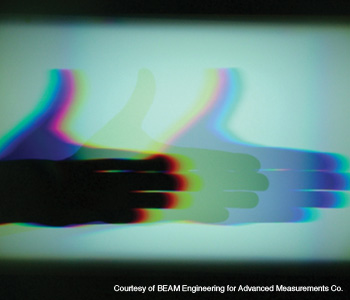Feature
The Promise of Diffractive Waveplates
Diffractive waveplates exhibit the high diffraction efficiency of Bragg gratings in micron-thick material layers.
 Broadband high efficiency diffraction of an unpolarized light by a diffractive waveplate is revealed in the image of a hand taken through the waveplate.
Broadband high efficiency diffraction of an unpolarized light by a diffractive waveplate is revealed in the image of a hand taken through the waveplate.
It sounds too good to be true: a micron-thick optical component with diffraction efficiency as high as a Bragg grating but with a spectrum of wavelengths and divergence angles that are two to three orders broader—plus electrical or optical switchability. If such a component were feasible, it may become a valuable photonics tool that could give displays the ability to use all available light; enable beam steering systems to become compact and tolerant to high power beams; and give spectrometers broadband gratings. It could also make biological and chemical sensors more sensitive and give spatial light modulators higher speed.
…Log in or become a member to view the full text of this article.
This article may be available for purchase via the search at Optica Publishing Group.
Optica Members get the full text of Optics & Photonics News, plus a variety of other member benefits.
